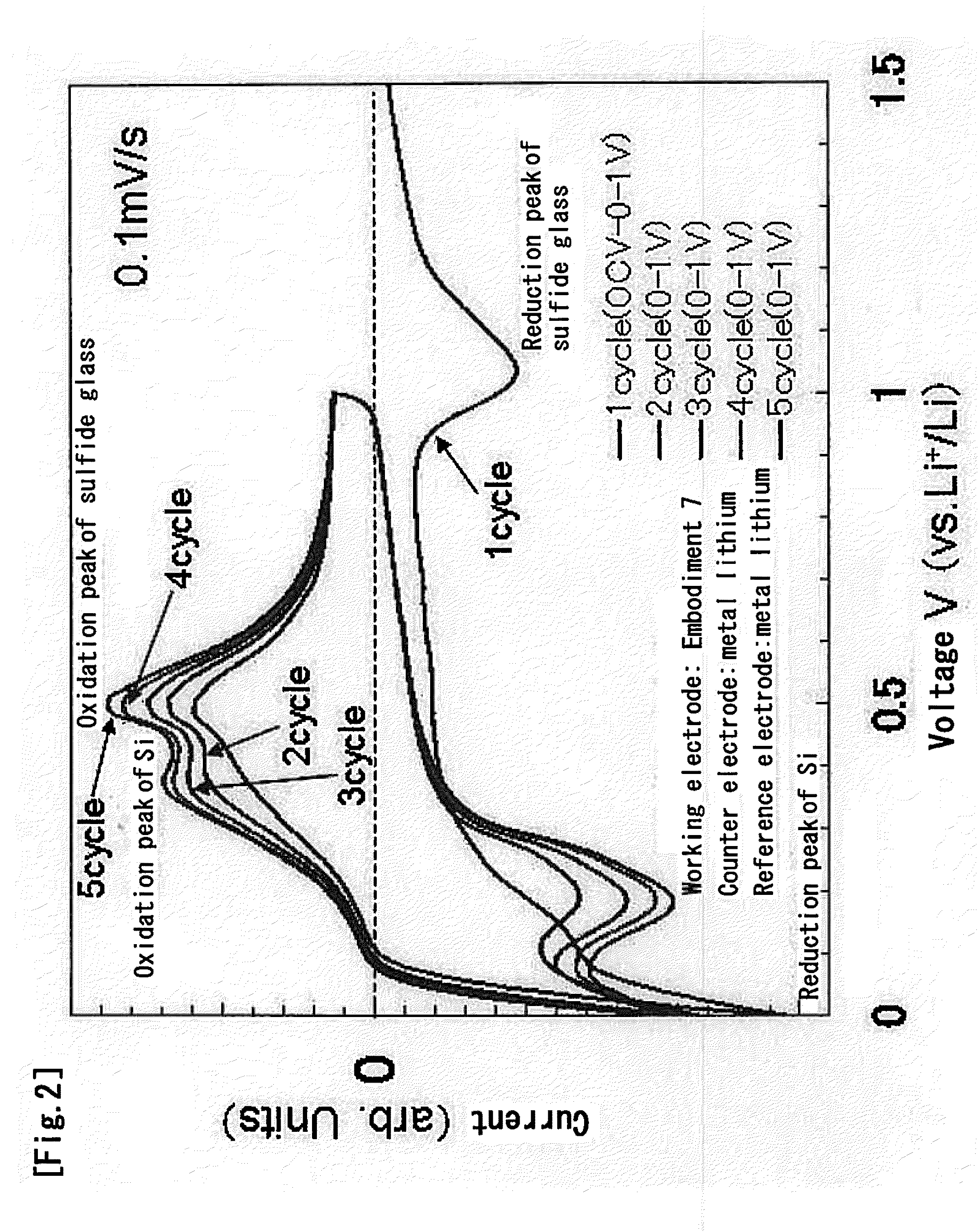Negative Electrode Material for Lithium Secondary Battery and its Manufacturing Method, and Negative Electrode for Lithium Secondary Battery, and Lithium Secondary Battery
a secondary battery and negative electrode technology, applied in the manufacture of final products, cell components, electrochemical generators, etc., can solve the problems of easy water reaction, achieve excellent cycle characteristics, high output performance, and easy to deal with
- Summary
- Abstract
- Description
- Claims
- Application Information
AI Technical Summary
Benefits of technology
Problems solved by technology
Method used
Image
Examples
reference examples 1-3
and Reference Examples 1-3
[0154]Using as starting materials component A and component B (sulfide glass) shown in Table 3 below, the composite powder with component B coated on the surface of component A was prepared through mechanical milling treatment using a zirconia ball and container (at normal temperature and normal pressure and under the atmosphere of argon gas).
[0155]The starting materials, the preparation ratio of component A and component B and synthesis conditions (acceleration of gravity, and time) used in Embodiments 1-36, Embodiments A-I, Comparative Examples 1-2 and Reference Examples 1-3 are shown in Table 3.
[0156]Concerning Embodiments 1-4 and 14-36 using only component B and Comparative Examples 1-2 using only component A, milling treatment was not performed. Regarding Reference Example 1-3, component A and component B were just mixed, and milling treatment was not performed.
[0157]The starting material for Embodiment 13 includes not only Si and sulfide 1 but also KB...
embodiments 37-41
[0158]By heating sulfide 1 (component B) shown in Tables 1 and 2, changing it into the state of melted glass, adding and dispersing component A in it and then cooling it naturally to room temperature, an ingot with component A dispersed in component B was prepared. By crushing the obtained ingot using a stirrer ‘Raikai’ mill, the composite powder with component B coated on component A was prepared. As a heat treatment condition, sulfide glass was heated up to 750° C. at the heating speed of 20° C. / hour and then retained at the same temperature for 12 hours. After that, it was cooled naturally to room temperature. The starting materials used in Embodiments 37-41 and the preparation ratio of A, B and KB are shown in Table 4 below.
[0159]Furthermore, in Embodiments 40, by heating sulfide 1 to 750° C., changing it into the state of melted glass, adding and dispersing component A and KB simultaneously in it and then cooling it naturally to room temperature, an ingot with component A and K...
embodiment 1
FIG. 1 Shows the CV (Cyclic Voltammetry) Measurement Results of
[0161]As is known from the CV measurement results shown in FIG. 1, a large reduction peak can be observed around 1 V during initial charge (the process of lithium absorption).
PUM
| Property | Measurement | Unit |
|---|---|---|
| temperature | aaaaa | aaaaa |
| mol % | aaaaa | aaaaa |
| mol % | aaaaa | aaaaa |
Abstract
Description
Claims
Application Information
 Login to View More
Login to View More - R&D
- Intellectual Property
- Life Sciences
- Materials
- Tech Scout
- Unparalleled Data Quality
- Higher Quality Content
- 60% Fewer Hallucinations
Browse by: Latest US Patents, China's latest patents, Technical Efficacy Thesaurus, Application Domain, Technology Topic, Popular Technical Reports.
© 2025 PatSnap. All rights reserved.Legal|Privacy policy|Modern Slavery Act Transparency Statement|Sitemap|About US| Contact US: help@patsnap.com



